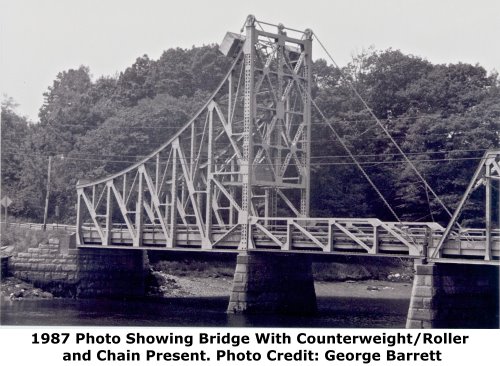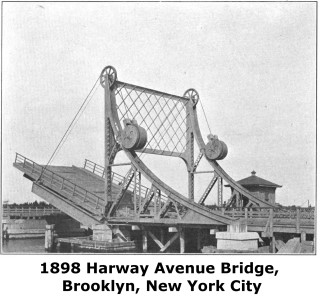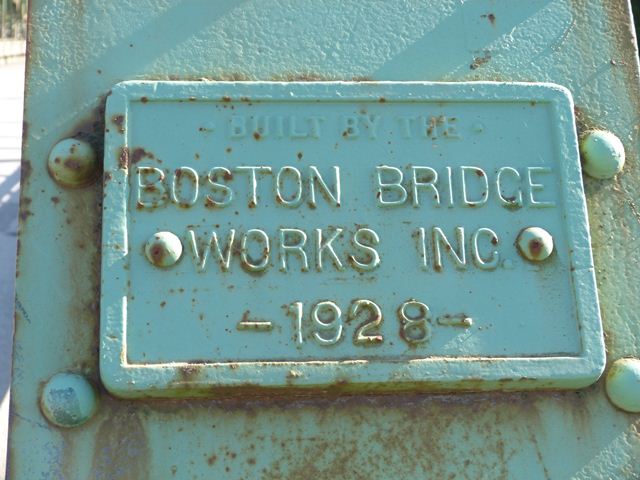We Recommend:
Bach Steel - Experts at historic truss bridge restoration.
BridgeHunter.com Phase 1 is released to the public! - Visit Now
Wadsworth Street Bridge

Primary Photographer(s): Nathan Holth
Bridge Documented: June 17, 2012
Wadsworth Street (Brooklyn Heights Road) Over St. George River
Thomaston: Knox County, Maine: United States
Metal 4 Panel Rivet-Connected Pratt Pony Truss, Movable: Single Leaf Bascule (Belidor) and Approach Spans: Metal 7 Panel Rivet-Connected Pratt Through Truss, Fixed
1925 By Builder/Contractor: Boston Bridge Works of Boston, Massachusetts
Not Available or Not Applicable
Not Available
231.0 Feet (70.4 Meters)
20 Feet (6.1 Meters)
1 Main Span(s) and 2 Approach Span(s)
2904

View Information About HSR Ratings
Bridge Documentation
This bridge no longer exists!
Bridge Status: Demolished and replaced.View Archived National Bridge Inventory Report - Has Additional Details and Evaluation
View Original Plans For This Historic Bridge
This bridge is one of the only examples in the country of a Belidor type of bascule bridge. This unusual type of bascule has a curved tower on which counterweights can roll, while pulling a cable attached to the bascule leaf, which raises the bridge. The bascule type was also built in Australia, where it is known as the "American" type of bascule. One one operable example is known to remain in the United States, the Glimmer Glass Bridge. The historical photo of a long-lost Belidor bascule in New York City is shown to the right in partially raised position, illustrating how the bascule operates. The Wadsworth Street Bridge no longer operates and indeed all of the machinery including counterweights and cables have been removed. All that remains is the the superstructure with its fixed traditional Pratt through truss span, the small single leaf pony truss bascule span, and the unusually shaped counterweight tower/track, which also doubles as a through truss approach span. The trunnions remain in place on the bascule span as well. Despite this massive loss of operating equipment, given the rarity of this bridge type, with only the aforementioned Glimmer Glass Bridge remaining in operable condition, the Wadsworth Street Bridge must still be assigned a high level of historic significance. Also, it should be noted that the Glimmer Glass Bridge, although operable, suffers from a substantial loss of original bridge material. Much has been replaced. In contrast, while the mechanics are lost on the Wadsworth Street Bridge, the structure that remains is largely in its original condition and design, and thus unaltered.
Information and Findings From Maine's Historic Bridge InventoryDiscussion of Bridge The 1925-28 bridge was designed and built as a rolling counterweight bascule bridge. The operating mechanism, operators shanty, and counterweights and guys have been lost, but the rolling counterweight design is
so rare that the integrity issues are considered secondary to the significance of the bridge type. The towers, trunnions, and counterweight track remain making it clear what type of bridge this was. Rolling counterweight bridges
date to the late 18th century in France. The Wadsworth Street bridge is historically and technologically significant as representing the rare and distinctive rolling counterweight bridge type. There were once several rolling
counterweight bascule bridges in the state, but all of the others have been completely lost. Bridge Considered Historic By Survey: Yes |
![]()
Photo Galleries and Videos: Wadsworth Street Bridge
Structure Overview
Original / Full Size PhotosA collection of overview photos that show the bridge as a whole and general areas of the bridge. This gallery offers photos in the highest available resolution and file size in a touch-friendly popup viewer.
Alternatively, Browse Without Using Viewer
![]()
Structure Details
Original / Full Size PhotosA collection of detail photos that document the parts, construction, and condition of the bridge. This gallery offers photos in the highest available resolution and file size in a touch-friendly popup viewer.
Alternatively, Browse Without Using Viewer
![]()
Structure Overview
Mobile Optimized PhotosA collection of overview photos that show the bridge as a whole and general areas of the bridge. This gallery features data-friendly, fast-loading photos in a touch-friendly popup viewer.
Alternatively, Browse Without Using Viewer
![]()
Structure Details
Mobile Optimized PhotosA collection of detail photos that document the parts, construction, and condition of the bridge. This gallery features data-friendly, fast-loading photos in a touch-friendly popup viewer.
Alternatively, Browse Without Using Viewer
![]()
Maps and Links: Wadsworth Street Bridge
This historic bridge has been demolished. This map is shown for reference purposes only.
Coordinates (Latitude, Longitude):
Search For Additional Bridge Listings:
Bridgehunter.com: View listed bridges within 0.5 miles (0.8 kilometers) of this bridge.
Bridgehunter.com: View listed bridges within 10 miles (16 kilometers) of this bridge.
Additional Maps:
Google Streetview (If Available)
GeoHack (Additional Links and Coordinates)
Apple Maps (Via DuckDuckGo Search)
Apple Maps (Apple devices only)
Android: Open Location In Your Map or GPS App
Flickr Gallery (Find Nearby Photos)
Wikimedia Commons (Find Nearby Photos)
Directions Via Sygic For Android
Directions Via Sygic For iOS and Android Dolphin Browser
USGS National Map (United States Only)
Historical USGS Topo Maps (United States Only)
Historic Aerials (United States Only)
CalTopo Maps (United States Only)




